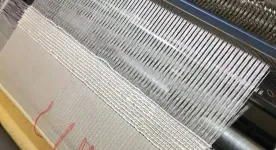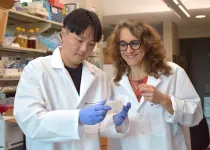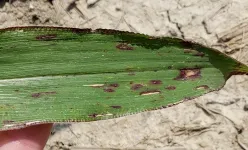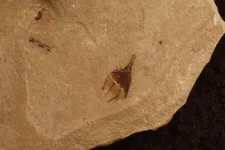(Press-News.org) University of Pittsburgh researchers have identified a type of immune cell that drives chronic organ transplant failure in a mouse model of kidney transplantation and uncovered pathways that could be therapeutically targeted to improve patient outcomes. The findings are published in a new Science Immunology paper.
“In solid organ transplantation, such as kidney transplants, one-year outcomes are excellent because we have immunosuppressant drugs that manage the problem of acute rejection,” said co-senior author Fadi Lakkis, M.D., distinguished professor of surgery, professor of immunology and medicine, and scientific director of the Thomas E. Starzl Transplantation Institute at Pitt and UPMC. “But over time, these organs often start to fail because of a slower form of rejection called chronic rejection, and current medications don’t seem to help. Understanding this problem was the motivation behind our study.”
Previously, Lakkis and his colleagues had shown that a type of immune cell called tissue-resident memory T cells drive chronic rejection. Like all memory T cells, these resident versions “remember” previously encountered threats by recognizing specific identifying features called antigens. But unlike most memory T cells, which circulate in the bloodstream, tissue-resident memory T cells live within organs.
In the new study, first author Roger Tieu, Ph.D., Medical Scientist Training Program student at Pitt, discovered two factors that maintain resident memory T cells in kidney grafts over time. The first is the antigen itself — the molecules that T cells use to recognize the donor graft as foreign. Because resident T cells dwell within the kidney graft, they’re constantly exposed to such antigens. The second factor is a cytokine, or inflammatory signaling protein, called IL-15.
Also key to this process is another type of immune cell called dendritic cells, which capture both the antigen and IL-15 and present them to receptors on resident memory T cells.
“Dendritic cells are like the conductor of the orchestra,” said Lakkis. “They’re critical for activating many types of immune cells and coordinating immune responses.”
When the researchers depleted dendritic cells or blocked their ability to present antigen or IL-15, they saw a drop in resident memory T cell quantity and functionality.
“Antigen and IL-15 are required for T cell maintenance,” said co-senior author Martin Oberbarnscheidt, M.D., Ph.D., assistant professor of surgery at Pitt. “If you remove either, resident memory cells decline in number. In a transplant patient, it’s not feasible to take the antigen away because it’s found throughout the donor organ, but targeting IL-15 is clinically translatable.”
Indeed, when the researchers blocked IL-15 signaling with an antibody that prevented IL-15 binding to its receptor on T cells, they found that graft survival was greatly prolonged in mouse kidney recipients.
The researchers hope that the findings could set the stage for clinical trials to test the antibody in transplant patients to minimize chronic rejection. Blocking IL-15 signaling could enable more precise targeting of resident memory T cells within the graft, while minimizing global immunosuppression of other T cells throughout the body that are important for immunity to infections.
“In my medical school training, I have had the privilege of working with transplant patients,” said Tieu. “I am excited that our work has the potential to be translated from lab to clinic, with the goal of mitigating chronic rejection and elevating quality of life for our patients.”
Other authors on the study were Daqiang Zhao, M.D., Ph.D., Gang Zhang, M.D., Neda Feizi, Ph.D., Priyanka Manandhar, Amanda L. Williams, M.S., Benjamin Popp, M.S., Michelle A. Wood-Trageser, Ph.D., Anthony J. Demetris, M.D., Lawrence P. Kane, Ph.D., Khodor I. Abou-Daya, M.D., and Warren D. Shlomchik, M.D., of Pitt or UPMC; Qiang Zeng, M.D., Nationwide Children’s Hospital; J. Yun Tso, Ph.D., JN Biosciences; and Aaron J. Johnson, Ph.D., Mayo Clinic.
This research was supported by the National Institutes of Health (R01 AI049466, R01 AI145881, R01 HL143349, R01 GM136148, R01 NS103212, T32 GM008208, T32 AI074490, F30 DK124925, 1S10OD011925-01 and 1S10OD019942-01) and the American Society of Transplantation.
##
END
Study points to new approach to treat chronic transplant rejection
2023-04-21
ELSE PRESS RELEASES FROM THIS DATE:
Cheaper method for making woven displays and smart fabrics – of any size or shape
2023-04-21
Researchers have developed next-generation smart textiles – incorporating LEDs, sensors, energy harvesting, and storage – that can be produced inexpensively, in any shape or size, using the same machines used to make the clothing we wear every day.
The international team, led by the University of Cambridge, have previously demonstrated that woven displays can be made at large sizes, but these earlier examples were made using specialised manual laboratory equipment. Other smart textiles can be manufactured in specialised microelectronic fabrication facilities, but these are highly expensive and produce large volumes of waste.
However, the team found that flexible ...
Researchers devise cascaded microfluidic circuits for pulsatile filtration of extracellular vesicles directly from whole blood samples
2023-04-21
Extracellular vesicles (EVs) are cell-secreted lipid bilayer bioparticles with a diameter of 30 to 250 nm. They are a promising source of biomarkers for liquid biopsies for early cancer diagnosis and real-time monitoring of tumor development. However, analysis of nanosized EVs in blood samples has been hampered by the lack of effective, rapid, and standardized methods to isolate and purify EVs.
In a study published in Science Advances, SUN Jiashu’s group from the National Center for Nanoscience and Technology (NCNST) of the Chinese Academy of Sciences (CAS) and collaborators from the Fifth Medical Center of the Chinese PLA General ...
Nanowire networks learn and remember like a human brain
2023-04-21
An international team led by scientists at the University of Sydney has demonstrated nanowire networks can exhibit both short- and long-term memory like the human brain.
The research has been published today in the journal Science Advances, led by Dr Alon Loeffler, who received his PhD in the School of Physics, with collaborators in Japan.
“In this research we found higher-order cognitive function, which we normally associate with the human brain, can be emulated in non-biological hardware,” Dr Loeffler said.
“This work builds on our previous research in which we showed how nanotechnology could be used to build a brain-inspired electrical device with neural ...
Long distance voyaging among the Pacific Islands
2023-04-21
Polynesian peoples are renowned for their advanced sailing technology and for reaching the most remote islands on the planet centuries before the Europeans reached the Americas. Through swift eastward migrations that are now well covered by archaeological research, Polynesian societies settled virtually every island from Samoa and Tonga to Rapa Nui/Easter Island in the east, Hawai’i in the north, and Aotearoa/New Zealand in the south. But little is known about Polynesian migrations west of the 180th meridian.
In order to better understand the relationship between these Polynesian societies of the western Pacific, Melanesia and Micronesia – often ...
Heart injury biomarker may help COVID-19 patients avoid hospitalization, new study shows
2023-04-21
A study led by the University of St Andrews suggests that a frequently used medical test for heart injury could one day be used to help COVID-19 patients avoid hospitalisation.
Cardiac troponins are proteins that form part of the heart’s contractile machinery and are released into the bloodstream when the heart is damaged. It can be measured in a blood test which is widely used in the assessment of heart attacks and other heart conditions.
Existing studies since 2020 have shown that COVID-19 patients who have elevated troponin levels are more likely to die or suffer adverse clinical outcomes compared with those who have normal ...
Study: Cells send maintenance crews to fix damaged protein factories
2023-04-21
JUPITER, Fla. — In a discovery fundamental to the inner workings of cells, scientists have discovered that if oxidative stress damages protein factories called ribosomes, repair crews may move in to help fix the damage so work can quickly resume.
The discovery, reported Friday in the journal Molecular Cell, could have implications for cancer, the aging process, and growth and development, said the study’s lead author, molecular biologist Katrin Karbstein, Ph.D., a professor at The Herbert ...
New stellar danger to planets identified by NASA'S Chandra program
2023-04-21
CHAMPAIGN, Ill. — An exploded star can pose more risks to nearby planets than previously thought, according to a new study from NASA’s Chandra X-ray Observatory and other X-ray telescopes. This newly identified threat involves a phase of intense X-rays that can damage the atmospheres of planets up to 160 light-years away.
The results of the study, led by researchers at the University of Illinois Urbana-Champaign, Washburn University and the University of Kansas, are published in the Astrophysical Journal.
Earth is not in danger of such a threat today because there are no potential supernova progenitors within this distance, but it may have experienced ...
Why are COVID-19 vaccination rates among children so low? Parents’ worry about long-term risks, responsibility
2023-04-21
Despite efforts by the U.S. Centers for Disease Control and Prevention and pediatric clinicians to increase the COVID-19 vaccination rate among children, many remain unvaccinated due to parental concerns about the vaccine’s long-term effects and anticipated responsibility. Those are findings from a new study published in Pediatricsand conducted by the Center for Economic and Social Research(CESR) at the USC Dornsife College of Letters, Arts and Sciences.
The researchers sought to determine the causes of low child vaccination rates. Currently, only 39% of children 5 to 11 and 68% of those 12 to 17 have received ...
Insignum AgTech and Beck’s collaborate to help corn ‘talk’
2023-04-21
ATLANTA, Ind. – Insignum AgTech® and Beck’s have signed an agreement to test Insignum’s innovative corn traits in Beck’s elite varieties. The companies will collaborate to cross the trait into proprietary Beck’s genetics for field-testing in 2023 to evaluate commercial viability of the traits.
Insignum AgTech develops plant genetic traits that enable plants to “talk” and signal to farmers when specific plant stresses begin.
“With this trait, a corn plant generates purple pigment, indicating that a fungal infection has started ...
New study uncovers Colorado’s spicy ancient history of chili peppers
2023-04-21
Botanists and paleontologists, led by researchers from the University of Colorado Boulder, have identified a fossil chili pepper that may rewrite the geography and evolutionary timeline of the tomato plant family.
The team’s findings, published last month in the journal New Phytologist, show that the chili pepper tribe (Capsiceae) within the tomato, or nightshade (Solanaceae), family is much older and was much more widespread than previously thought. Scientists previously believed that chili peppers evolved in South America at most ...









